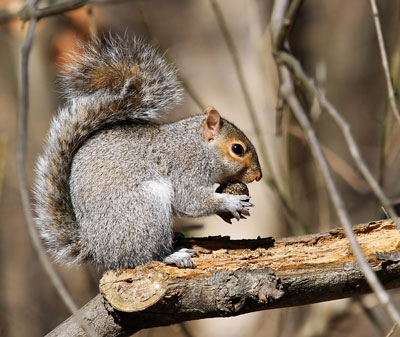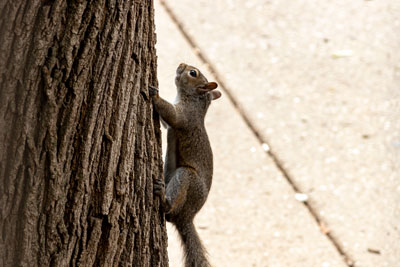




In Montana, we have two native species of tree squirrel, the red squirrel and northern flying squirrel. In addition, we have one or possibly two exotic (non-native) species, the fox squirrel and perhaps the eastern gray squirrel. Most damage and nuisance complaints are usually about the exotic fox squirrels, which have been imported and have flourished in a number of Montana towns and cities.
In town, these squirrels are without natural controls and their populations have reached excessive numbers. They are invading bird feeders, attics, sheds, and garages. They are falling down chimneys and stove and ventilation pipes. They are eating fruits and nuts, flower bulbs, vegetable plants, and ornamentals. They feed on our garbage, unprotected pet food, and even uncovered BBQ grills.
Be careful of bird feeders. We love to watch birds, but bird feed attracts squirrels and it can artificially increase the squirrel population in your yard. Feeders are difficult to "squirrel-proof," but you can attach baffle cones, use metal poles and make sure they are 6 feet off the ground and at least 10 feet away from trees, branches, structures, and other possible launching pads to your feeder. Hanging feeders are hard to protect. Any squirrel can access a feeder hanging from a tree branch.
You can put mesh netting over plants and small trees, but make sure it is secure around the bottoms or you'll have squirrels on the inside. Squirrels love tulips and crocus bulbs; you may need to plant daffodils instead, which are unpalatable to most animals. You can put mesh wire around the base of potted plants or over crocus and tulip bulbs in the soil. Trap squirrels out of gardens and landscape shrubs.
Squirrels are so agile that they can climb and launch off of almost anything onto your house, out buildings, bird feeders, etc. Band all the trees within 10 feet of a problem area with sheet metal cut 3 feet wide and placed 6 to 8 feet off the ground. Secure with bungee cord and loosen once a year to allow tree growth.
The best solution to squirrel problems is to limit squirrel populations. Proper maintenance and sanitation is the first step. Removing food, shelter, and access are important. Overall the best management tool is shooting, where feasible, or trapping to minimize or eliminate squirrels from your property. Luckily squirrels are easy to catch outside.
There are no known long-term or effective squirrel repellents. Rodenticides designed for rats and mice are ineffective, and there are no toxicants or fumigants registered at this time.
When squirrels invade your house or other buildings, they can do extensive damage. They can get into many homes, and once there are difficult to eliminate and deter. If squirrels discover a partial entrance such as a broken window, a construction gap, a roof vent, a damaged piece of trim, or loose roofing, they'll finish the job and enlarge the entrance into your home. They can get into anything they can fit their head through. The space between the facia board and the roof is the most vulnerable to them. Once in a while, they will cause damage to insulation, rafters, and electric wires.
If you get squirrels in your house, you've got to get them out. Squirrels are diurnal and are outside most of the day. You may be able to close off their entrance when they are out, or you may install a one-way exit over the entrance. Often the only practical way is to remove the squirrels, dead or alive, through trapping. Then you must make immediate repairs to close the entrance hole(s). Large rat traps, Conibear 55 or 110 traps, or No. 0 or No. 1 leg-hold traps will provide a lethal solution. Havahart type live traps may also be used, but then what do you do with the squirrel? You can kill it or relocate it. Technically relocation is illegal, not advisable biologically, and who wants to inherit your problem? Best trap baits are sunflower seeds, peanut butter, nuts, anise oil, shelled corn, or slices of apple.
If a squirrel falls down a chimney or stove pipe and can't get out, lower a braided rope down to the bottom and leave it. They'll usually climb up the rope and out within a few hours.
Squirrels are intelligent, persistent, and agile adversaries. They can climb a vertical brick face, scale a vertical aluminum-sided house, or run up a gutter spout as easily as climbing a tree, and they can run along, over or underhanded, on utility wires just as effortlessly. To keep them out:
